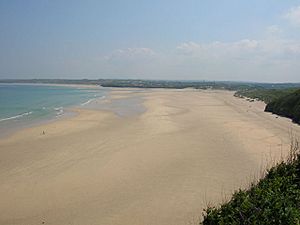Hayle Estuary and Carrack Gladden SSSI facts for kids
| Site of Special Scientific Interest | |

Porth Kidney Sands
|
|
| Coordinates | 50°11′31″N 5°26′06″W / 50.192°N 5.435°W |
|---|---|
| Interest | Biological |
| Area | 191.8 hectares (1.918 km2; 0.7405 sq mi) |
| Notification | 1951 |
The Hayle Estuary and Carrack Gladden SSSI is a special place in west Cornwall, England. It's known for its amazing plants and animals. SSSI stands for Site of Special Scientific Interest.
This important area has three main parts. These are the Hayle Estuary, the sandy Porth Kidney Sands, and the rocky Carrack Gladden headland. Each part is unique and helps make this whole area special.
Contents
Exploring the Hayle Estuary and Carrack Gladden
This special area is located on the southern side of St Ives Bay. It sits just west of the town of Hayle. The River Hayle flows into the sea here. This estuary is the most south-westerly in all of Britain.
It's also very important for birds. Many birds use this area during their long journeys. They cross the Land's End peninsula nearby. Part of the estuary, called Ryan's Field and Carnsew Pool, is owned by the Royal Society for the Protection of Birds (RSPB). This group works to protect birds and their homes.
Walking Paths and Railways
You can explore this area on foot! Two long walking paths go through or near the SSSI. The South West Coast Path follows the coastline. It goes from Carrack Gladden all the way to North Quay in Hayle.
Another path, St Michael’s Way, also follows the coast at Carrack Gladden. It continues as far as Griggs Quay. The St Ives Bay Line train track also runs along part of the SSSI's edge.
Amazing Birdlife of the Estuary
The Hayle Estuary is super important for birds. Because it's the most south-westerly estuary in Britain, it's a key stop for many birds. It's a vital place for ducks, wading birds, and gulls during winter. Sometimes, rare birds from North America even visit! These are called "vagrants" because they are usually found somewhere else.
Winter Birds and Visitors
The most common ducks you'll see here are Eurasian teal and Eurasian wigeon. You might also spot a few gadwall, common goldeneye, and red-breasted mergansers.
In winter, many wading birds come to feed. These include red knot, spotted redshank, common greenshank, and common sandpiper. You might also see Little egrets with their white feathers.
Migrating Birds and Rare Sightings
When birds are migrating, even more waders visit the estuary. This is when you might see those rare North American "vagrants." Some of the more frequent ones include pectoral sandpiper, white-rumped sandpiper, and long-billed dowitcher. Birdwatchers love to visit and try to spot these special visitors!
A Look into the Past: Mining History
The area around Carrack Gladden has a history of mining. Hawke's Point Mine, also known as Wheal Fanny Adela, operated here. It was open between 1851 and 1870. Miners dug up 670 tons of copper and 1 ton of ochre, which is a type of natural earth pigment. They also found some tin.
Mine Workings and What They Found
The main mining work happened at Carrack Gladden. You can still see tunnels from the beach today! The mine at Hawke's Point was reopened in 1883. At that time, nineteen men worked there.
Miners found that an old tunnel, called an adit, just missed a large amount of copper. They also discovered cobalt, another valuable metal. In 1884, the mine's tools and buildings were sold off. This included a large wooden house, a horse-powered lifting machine, and a stone crusher.

